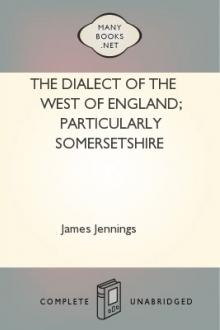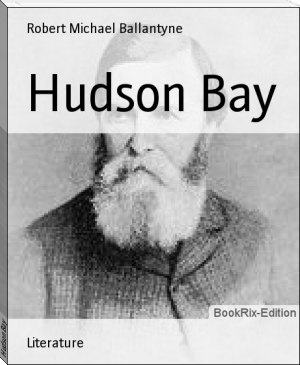Handbook to the new Gold-fields, R. M. Ballantyne [mobi reader android .TXT] 📗

- Author: R. M. Ballantyne
Book online «Handbook to the new Gold-fields, R. M. Ballantyne [mobi reader android .TXT] 📗». Author R. M. Ballantyne
Mr Dunn, in his valuable “History of the Oregon Territory,” thus describes the country and climate:— “After the Columbia, the river next in importance is Fraser River. It takes its rise in the Rocky Mountains, near the source of Canoe River, taking a north-west course of eighty miles. It then turns to the southward, receiving Stuart’s River, which rises in a chain of lakes in the northern boundary of the territory. It then pursues a southerly course, and after receiving many tributaries, breaks through the cascade range of hills in a series of falls and rapids; and after a westerly course of seventy miles, empties itself into the Gulf of Georgia, in latitude 49 degrees 7 minutes north. This latter portion is navigable for vessels that can pass its bar drawing ten feet of water. Its whole length is 350 miles. There are numerous lakes scattered through the several sections. The country is all well watered; and there are but four places where an abundance of water cannot be obtained, either from lakes, rivers, or springs.
“The climate of the western division is mild throughout the year, neither the cold of winter, nor the heat of summer predominating. The mean temperature is about 50 degrees Fahrenheit. The prevailing winds, in summer, are from the northward and westward, and in winter, from the west, south, and south-east. The winter lasts from about November till March, generally speaking. During that time there are frequent falls of rain, but not heavy. Snow seldoms lies longer than a week on the ground. There are frosts so early as September, but they are not severe, and do not continue long. The easterly winds are the coldest, as they come from across the mountains, but they are not frequent. Fruit trees blossom early in April in the neighbourhood of Nasqually and Vancouver; and in the middle of May pease are a foot high, and strawberries in full blossom; indeed, all fruits and vegetables are as early there as in England. The hills, though of great declivity, have a sward to their tops. Lieutenant Wilkes says, that out of 106 days, 67 were fair, 19 cloudy, and 11 rainy. The middle section is subject to droughts. During summer the atmosphere is drier and warmer, and in winter colder than in the western section; its extremes of heat and cold being greater and more frequent. However, the air is fine and healthy; the atmosphere in summer being cooled by the breezes that blow from the Pacific.
“The soil of the western section varies from a deep black vegetable loam to a light brown loamy earth. The bills are generally basalt stone and slate. The surface is generally undulating, well watered, well wooded, and well adapted for agriculture and pasturage. The timber consists of pine, fir, spruce, oaks (white and red), ash, arbutus, cedar, arbor-vitae, poplar, maple, willow, cherry, tew, with underwoods of hazel and roses. All kinds of grain, wheat, rice, barley, oats, and pease, can be procured there in abundance. Various fruits, such as pears, apples, etcetera, succeed there admirably; and the different vegetables produced in England yield there most abundant crops.
“The middle section, which is about 1000 feet above the level of the western, is not so well wooded or fertile; yet in the southern parts of it, where the missionaries have established settlements, they have raised excellent crops, and reared large stocks of cattle. Notwithstanding the occasional cold, their cattle are not housed, nor is provender laid in for them in any quantity, the country being sufficiently supplied with fodder in the natural hay, that is everywhere abundant in the prairies, which the cattle prefer.”
Mr Wilkes says, “In comparison with the United States, I would say, that the labour necessary in this territory to acquire wealth or subsistence is in the proportion of one to three; or in other words, a man must work throughout the year three times as much in the United States to gain the like competency. The care of stock, which requires so much time with us, requires no attention there, and on the increase only, a man might find support.” He further says, “There will be also a demand for the timber of this country at high prices, throughout the Pacific. The oak is well adapted for ship timber, and abundance of ash, cedar, cypress, and arbor-vitae may be had for other purposes, building, fuel, fencing,” etcetera. He also adds, “No part of the world affords finer inland sounds, or a greater number of harbours, than are found within the Straits of Juan de Fuca, capable of receiving the highest class of vessels, and without a danger in them which is not viable. From the rise and fall of the tides (eighteen feet) every facility is afforded for the erection of works for a great maritime nation. The country also affords as many sites for maritime power as any other.”
On the northern coast there are a number of islands which belong to the territory. The largest are Vancouver’s Island, and Queen Charlotte Island, both of which enjoy a mild and salubrious climate, with a soil well adapted to agriculture. They have also an abundance of fine fish in their waters. Coal of a very good quality is found there close by the surface, and they also contain numerous veins of valuable minerals.
All the rivers abound in salmon of the finest quality, which run twice a year, beginning in May and October, and appear inexhaustible. In Fraser River, the salmon are very numerous. The bays and inlets abound with several kinds of salmon, sturgeon, cod, carp, sole, flounders, perch, herring, and eels; also with shell-fish—crabs, oysters, etcetera. Whales and sea otters in numbers are found along the coast, and are frequently captured by Indians, in and at the mouth of the Straits of Juan de Fuca.
Game abounds in the western section, such as elk, deer, antelopes, bears, wolves, foxes, musk-rats, martins. And in the spring and fall, the rivers are covered with geese, ducks, and other water-fowl. Towards the Rocky Mountains buffaloes are found in great numbers.
From the advantages this country possesses, it bids fair to have an extensive commerce, on advantageous terms, with most parts of the Pacific. It is well calculated to produce the following staple commodities,—furs, salted beef and pork, grain, flour, wool, hides, tallow, timber, and coals. And in return for these—sugars, coffee, and other tropical productions may be obtained at the Sandwich Islands. Advantages that in time must become of immense importance.
Those districts of British America west of the lakes which by soil and climate are suitable for settlement, may be thus enumerated:—
Vancouver’s Island 16,200 square miles.
Fraser and Thomson Rivers 60,000 ditto
Sources of the Upper Columbia 20,000 ditto
Athabasca District 50,000 ditto
Saskatchewan, Red River, Assineboin, etcetera. 360,000 ditto
506,200
Under these geographical divisions we propose to give the results of a parliamentary investigation (just published) into the affairs of the Hudson’s Bay Company, so far as they are descriptive of the foregoing districts:—
Vancouver’s Island.This island is fertile, well timbered, finely diversified by intersecting mountain ranges, and small prairies, with extensive coal fields, compared by one witness to the West Riding of Yorkshire coal, and fortunate in its harbours. Esquimault Harbour, on which Victoria is situated, is equal to San Francisco. The salmon and other fisheries are excellent; but this advantage is shared by every stream and inlet of the adjacent coast. The climate is frequently compared with England, except that it is even warmer. The winter is stormy, with heavy rains in November and December; frosts occur in the lowlands in January, but seldom interrupt agriculture; vegetation starts in February, rapidly progressing in March and fostered by alternate warm showers and sunshine in April and May—while intense heat and drought are often experienced during June, July, and August. As already remarked, the island has an area of 16,200 square miles.
Fraser and Thompson Rivers.Northward of Vancouver’s Island the coast range of mountains trends so near the Pacific as to obstruct intercourse with the interior, but “inside,” in the language of a witness, “it is a fine open country.” This is the valley of Fraser River. Ascending this river, near Fort Langley, “a large tract of land” is represented as “adapted to colonists;” while of Thomson River, the same witness says that it is “one of the most beautiful countries in the world”—“climate capable of producing all the crops of England, and much milder than Canada.” The sources of Fraser River, in latitude 55 degrees, are separated from those of Peace River (which flows through the Rocky Mountains, eastward, into the Athabasca) by the distance of only 317 yards.
Sources of the Columbia.A glance at the map will shew how considerable a district of British Oregon is watered by the Upper Columbia and its tributary, the McGillivray or Flat Bow river. It is estimated above at 20,000 square miles, and has been described in enthusiastic terms, by the Bishop of Oregon—De Smet—in his “Oregon Missions.” The territory of the Kootonais Indians would seem, from his glowing description, to be divided in favourable proportion between forests and prairies. Of timber, he names birch, pine of different species, cedar, and cypress. He remarked specimens of coal, and “great quantities of lead,” apparently mixed with silver. The source of the Columbia seemed to impress him as “a very important point.” He observes that “the climate is delightful”—that the extremes of heat and cold are seldom known, the snow disappearing as it falls. He reiterates the opinion “that the advantages nature seemed to have bestowed on the Columbia, will render its geographical position very important at some future day, and that the hand of civilised man would transform it into a terrestrial paradise.”
It is an interesting coincidence that Bishop De Smet published in a Saint Louis paper, a few months since, a similar description of this region, adding that it could be reached from Salt Lake City along the western base of the Rocky Mountains with waggons, and that Brigham Young proposed to lead his next Mormon exodus to the sources of the Columbia River. Such a movement is not improbable, and would exhibit far greater sagacity than an emigration to Sonora.
The Athabasca District.The valleys of the Peace and Athabasca Rivers, which occupy the eastern base of the Rocky Mountains from latitudes 55 degrees to 59 degrees share the Pacific climate in a remarkable degree. The Rocky Mountains are greatly reduced in breadth and mean elevation, and through the numerous passes between their lofty peaks the winds of the Pacific reach the district in question. Hence it is that Sir Alexander Mackenzie, under date of 10th May, mentions the “exuberant verdure of the whole country”—trees about to blossom, and buffalo attended by their young. During the late parliamentary investigation, similar statements were elicited. Dr Richard King, who accompanied an expedition in search of Sir John Ross, as “surgeon and naturalist,”





Comments (0)